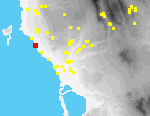 I20
Vromoneri Nozaina
I20
Vromoneri Nozaina
Site I20 is located on a small promontory, ca. 3.5 km. SE of Marathopolis. The promontory is almost entirely covered with maquis[110.15] and is bordered by cliffs that drop precipitously ca. 15 m. into the sea. At the foot of the cliffs are large, jagged rocks that have fallen from the promontory. Immediately N of the promontory is a small unsheltered cove with a shallow gravel beach at its E side; in the sea scarps above the cove are extensive exposures of clay, covered by a cap of beach rock.[090.35] The beach cannot be easily reached from the promontory.
Very eroded potsherds and lithics were collected principally in two small clearings bordered by low maquis-covered scarps, one near the N edge of the promontory.[090.36], the other ca. 6 m. to the S. In both areas, the artifacts rest on bedrock in deep red soils, almost totally deflated. These clearings constitute only ca. one-quarter of the surface area of the promontory; elsewhere it is clear that the maquis is covering deeper soils, and perhaps also cultural deposits, as deep as a meter; in places a brown soil is also preserved on top of the red.
The pottery is concentrated in the northern clearing; lithics are present there also, but are most plentiful in the southern clearing where pottery is scarce. All surface artifacts were collected from both clearings in 1993. Two years later in 1995 no new pottery or lithics were found in the southern clearing but in the northern clearing the surface density of potsherds was high-nearly 500 sherds, all of the same homogenous "Nozaina" fabric (see catalogue, below), lay in a single square meter area. It appears that pottery is here being brought to the surface as a result of continued deflation of the shallow red soil in which it is contained, and is not being eroded from the scarps that border the clearing.
The pottery from this site forms an unusually homogeneous group. It consists almost exclusively of EH II material, in a standard range of shapes. However, much of the pottery is in a distinctive coarse fabric. This is light brown to dark reddish-brown in color, with large white stone and smal sandy inclusions. It was used not only for standard coarse-ware jars, but also for a sauceboat (920111-9) and other shapes which normally appear elsewhere in fine ware. This same fabric (which we have called "Nozaina Ware") was also recognized at Romanou (I4) and Vergina Rema (I28), which are coastal sites like Nozaina. However it also appears at Kalantina (1) (Site M1), well inland.
Several conical bowls of EH II date are made in a finer, hard-fired fabric. There are also seven worn, small body sherds whose fabric closely resembles LH IIIB palace ware. These represent the only possibly later material at the site. It may be, however, that they too are EH II; a fine pale EH II fabric is known in other regions of Greece.